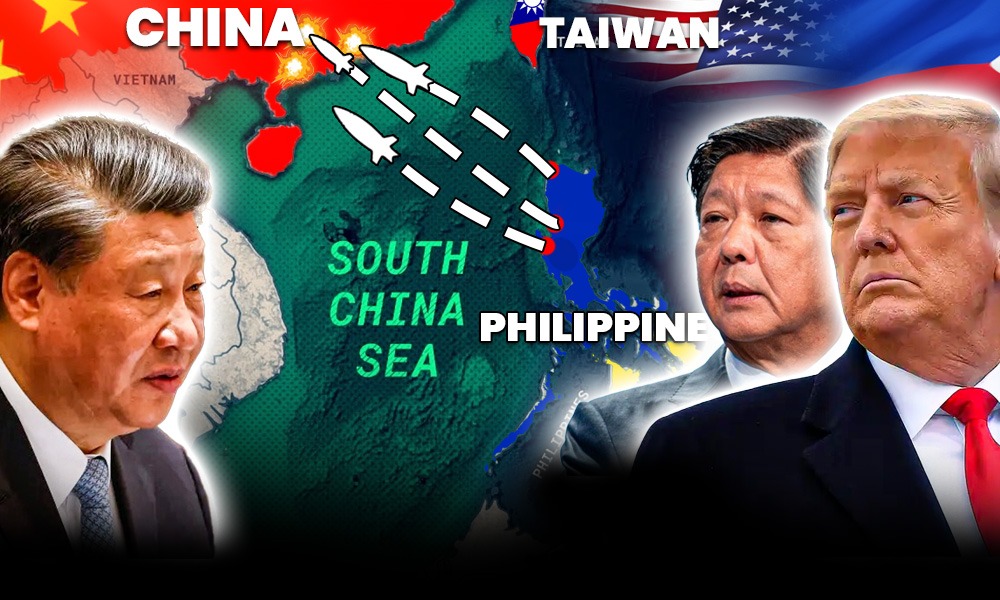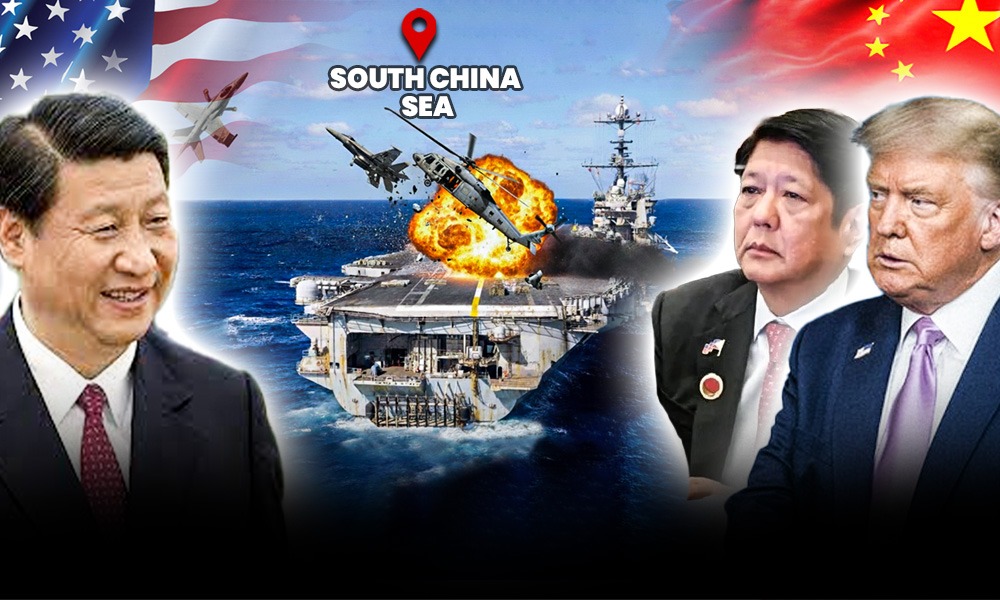“We don’t train for war because we want it, we train to prevent it,” declared Lt. Gen. James Glynn, summing up the intensity and intent behind the most realistic Balikatan exercise in history. Against the backdrop of an increasingly volatile Indo-Pacific, the 2025 Balikatan drills aren’t just routine joint training, they’re a bold statement. For the first time ever, U.S. and Philippine forces executed a full-scale battle simulation, including live missile strikes, coordinated island defense, and counter-invasion operations near the Luzon Strait, just 200 kilometers from Taiwan.
As tensions continue to surge in the South China Sea, and China ramps up pressure on Taiwan, this year’s Balikatan marks a historic shift from symbolic cooperation to hard-power deterrence. It reflects the evolving urgency among allies to prepare for worst-case scenarios, not tomorrow, but today.This is more than just a military drill. It’s a strategic message: the Philippines is stepping forward as a frontline ally, while the U.S. doubles down on deterrence in Asia’s most contested waters. Balikatan 2025 is proof that in the face of rising Chinese aggression, alliance strength and regional readiness are no longer optional, they’re survival.
Background on Balikatan Exercises
The word “Balikatan” comes from the Filipino phrase meaning “shoulder-to-shoulder,” a powerful symbol of the enduring partnership between the Philippines and the United States. Rooted in the 1951 Mutual Defense Treaty, Balikatan began as a modest series of joint training exercises designed to enhance military cooperation and interoperability between the two long-time allies.Over the decades, Balikatan has evolved in both scale and complexity. What once started as basic field exercises has grown into a multifaceted military operation involving thousands of troops, cutting-edge technology, and strategic coordination across land, sea, air, and now, cyberspace.
Each iteration reflects the shifting security dynamics of the Indo-Pacific.But Balikatan 2025 stands in a league of its own. With over 17,000 personnel, the largest force to date, and including live-fire missile drills, amphibious assaults, and simulated island invasions, this year’s exercise is unprecedented in both scope and realism. It marks the first time the allies have conducted a full-scale battle simulation near the Luzon Strait, a critical chokepoint between the South China Sea and Taiwan Strait. As threats grow more complex and urgent, Balikatan has become a vital rehearsal for real-world contingencies, not just a drill, but a deterrent.
What’s New in 2025: A Full-Scale Combat Simulation
Balikatan 2025 is rewriting the playbook. For the first time in the history of US-Philippines joint drills, a full-scale combat simulation has been launched, and it’s nothing short of historic. This year’s exercise features live-fire missile drills, including the use of HIMARS (High Mobility Artillery Rocket System), NMESIS (Navy/Marine Expeditionary Ship Interdiction System), and even the ground-launched Mid-Range Capability (MRC) missile system, capable of striking targets over 1,600 kilometers away. These advanced systems simulate striking enemy warships and coastal defenses, a clear signal to any potential aggressor.A key highlight is the joint defense scenario against a simulated island invasion in the Luzon Strait, a strategic maritime chokepoint linking the South China Sea and the Pacific, just north of Taiwan.
Anti-ship operations, amphibious assaults, and air support coordination are all part of the integrated mission set.New this year is the incorporation of Maritime Key Terrain Security Operations (MKTSO), simulated capture and defense of strategic islets and sea lanes, closely resembling contested zones in the South China Sea and near Taiwan’s southern approach.Balikatan 2025 is no longer just bilateral. It has transformed into a multinational effort, with the participation of Japan, Australia, the United Kingdom, France, and Canada. Their inclusion reflects not only growing concern over Chinese assertiveness, but also a broadening regional and global commitment to Indo-Pacific security. This year’s drill is a rehearsal for deterrence, with eyes set firmly on real-world flashpoints.
Strategic Location: Why the Philippines Matters
In the evolving chessboard of Indo-Pacific geopolitics, the Philippines stands as a critical node in the United States’ First and Second Island Chain strategy, a layered defense concept designed to contain China’s maritime ambitions. The First Island Chain, stretching from Japan through Taiwan to the Philippines and Borneo, is seen as the front line of deterrence. The Second Island Chain, further east, provides depth for counter-offensive operations and logistical support.The Philippines’ geography is central to this equation. Its northernmost province of Batanes lies just 200 kilometers from Taiwan and sits near the Bashi Channel, a vital undersea communication and naval transit route.
In the west, Second Thomas Shoal, where a grounded Philippine ship acts as a forward outpost, remains a flashpoint in the South China Sea.The modernization and strategic use of bases in Batanes, Palawan, and Balabac give Manila and its allies key vantage points to monitor and, if necessary, disrupt hostile maritime activity. These locations can host surveillance systems, anti-ship missiles, and rapid deployment forces, making the archipelago not just a passive ally, but a launchpad for regional defense and deterrence. In any Taiwan contingency or South China Sea standoff, the Philippines is no longer a bystander, it’s a frontline player.
A New Cold War Weapon? NMESIS Deployed in the Philippines During Balikatan
Geopolitical Implications and China’s Reaction
China’s response to Balikatan 2025 was swift and sharp. A spokesperson from Beijing echoed a familiar warning: “Those who play with fire will burn themselves.” To the Chinese Communist Party, the enhanced U.S.-Philippines alliance, particularly the simulated defense of Taiwan and joint anti-ship operations in the Luzon Strait, crosses a strategic red line.Beijing has long viewed both Taiwan and the South China Sea as non-negotiable core interests. Any perceived challenge to its sovereignty, especially from the U.S. led military coalitions, is seen as a direct provocation. The expanded U.S. military footprint in the Philippines, including the use of Enhanced Defense Cooperation Agreement (EDCA) sites near Taiwan, is deeply unsettling for China’s leadership.
The deployment of advanced U.S. missile systems like HIMARS and NMESIS, coupled with multi-nation participation, signals a clear shift toward active regional deterrence.This has raised fears of an escalating arms race in the Indo-Pacific. China is already responding with more frequent air and naval patrols, enhanced missile testing, and increased militarization of artificial islands in contested waters. The risk is no longer theoretical: the proximity of rival forces increases the chances of a miscalculation that could spiral into open conflict.Balikatan 2025 sends a strategic message, but whether that message deters China or provokes further aggression remains the defining question of this decade.
The Message to the Indo-Pacific and Beyond
Balikatan 2025 is not just a bilateral military exercise, it’s a geopolitical broadcast. The U.S. has made it clear: its strategic pivot remains firmly focused on the Indo-Pacific. By “assuming risk elsewhere to prioritize China as the sole pacing threat,” the Pentagon has recalibrated its global defense posture. That means fewer resources in Europe and the Middle East, and more firepower, partnerships, and deterrence measures in Asia.Interestingly, this shift has transcended political divides. Despite a change in leadership, Trump’s second term continues Biden’s Indo-Pacific momentum.
The continuity highlights bipartisan consensus in Washington: deterring China’s expansionism is America’s top strategic priority. This year’s Balikatan drills, featuring cutting-edge missile platforms, joint island-defense ops, and multinational participation, exemplify this resolve.But the message isn’t meant to provoke. As Gen. Romeo Brawner emphasized, “Our goal is deterrence, not aggression.” Balikatan 2025 is a visible reminder to allies and adversaries alike that the Philippines and the U.S., together with like-minded partners, are ready to defend peace, sovereignty, and the rules-based order. To the Indo-Pacific and beyond, the takeaway is clear: a stable region starts with credible deterrence and unity among allies.
Defense Cooperation: A Strengthened Alliance
Under President Ferdinand Marcos Jr., U.S.-Philippine defense cooperation has experienced a powerful resurgence. After years of uncertainty during the Duterte administration, the alliance has regained momentum, symbolized by the expansion of the Enhanced Defense Cooperation Agreement (EDCA), now granting the U.S. access to 9 strategic Philippine bases, up from the previous 5. These include new forward-operating sites in northern Luzon and Palawan, positioned near hotspots like Taiwan and the South China Sea.This shift reflects renewed trust and alignment between Manila and Washington, especially as regional tensions with China intensify.
The 2025 Balikatan drills serve not only as a training opportunity but as a testament to revived military interoperability. U.S. and Philippine forces are now better integrated, from command-and-control systems to real-time battlefield coordination.Balikatan also fosters joint readiness, simulating real-world scenarios that both nations could face in a crisis. From launching HIMARS to defending island chains, troops from both sides are developing muscle memory for a conflict that everyone hopes to prevent, but must be prepared for. In this era of strategic competition, the Philippines has become a frontline partner in upholding regional peace and deterrence.
Future Outlook: What Comes Next?
The trajectory of the Balikatan exercises signals an era of even greater multinational cooperation and regional preparedness. With nations like Japan, Australia, the UK, France, and Canada participating in 2025, the stage is set for future drills to expand into full-spectrum Indo-Pacific deterrence operations. Analysts suggest that upcoming iterations could include stronger coordination with QUAD nations and even deeper collaboration with ASEAN partners, reinforcing a collective defense posture.Beyond alliance-building, the spotlight is also on the continued modernization of the Philippine Armed Forces.
Investments in radar systems, coastal defense, and air mobility, combined with hands-on experience from these war games, aim to close capability gaps and raise operational standards. The goal: a self-reliant, agile military able to secure its territory and contribute meaningfully to regional peace.Strategically, the message is clear, the Philippines is no longer a passive bystander caught between great powers. Through Balikatan and beyond, it is asserting itself as an active, reliable defense partner, central to upholding the rules-based order in the Indo-Pacific. As tensions rise, Manila is not just preparing, it’s positioning itself as a key player in shaping the region’s security future.
Conclusion: More Than Just an Exercise
Balikatan 2025 is more than a routine military exercise; it’s a bold demonstration of resolve, unity, and regional leadership. As the first-ever full-scale combat simulation between the U.S. and the Philippines, it highlights a deepened commitment to preserving peace and stability in the Indo-Pacific. With new partners and unprecedented scale, this year’s drills reflect a unified front against aggression and a clear message to global powers. In an era of rising uncertainty, “shoulder-to-shoulder” is not just a slogan, it’s a strategic necessity for ensuring a secure, prosperous future for the region.
Philippines, US Launch Mid Range Missile System in Balikatan



